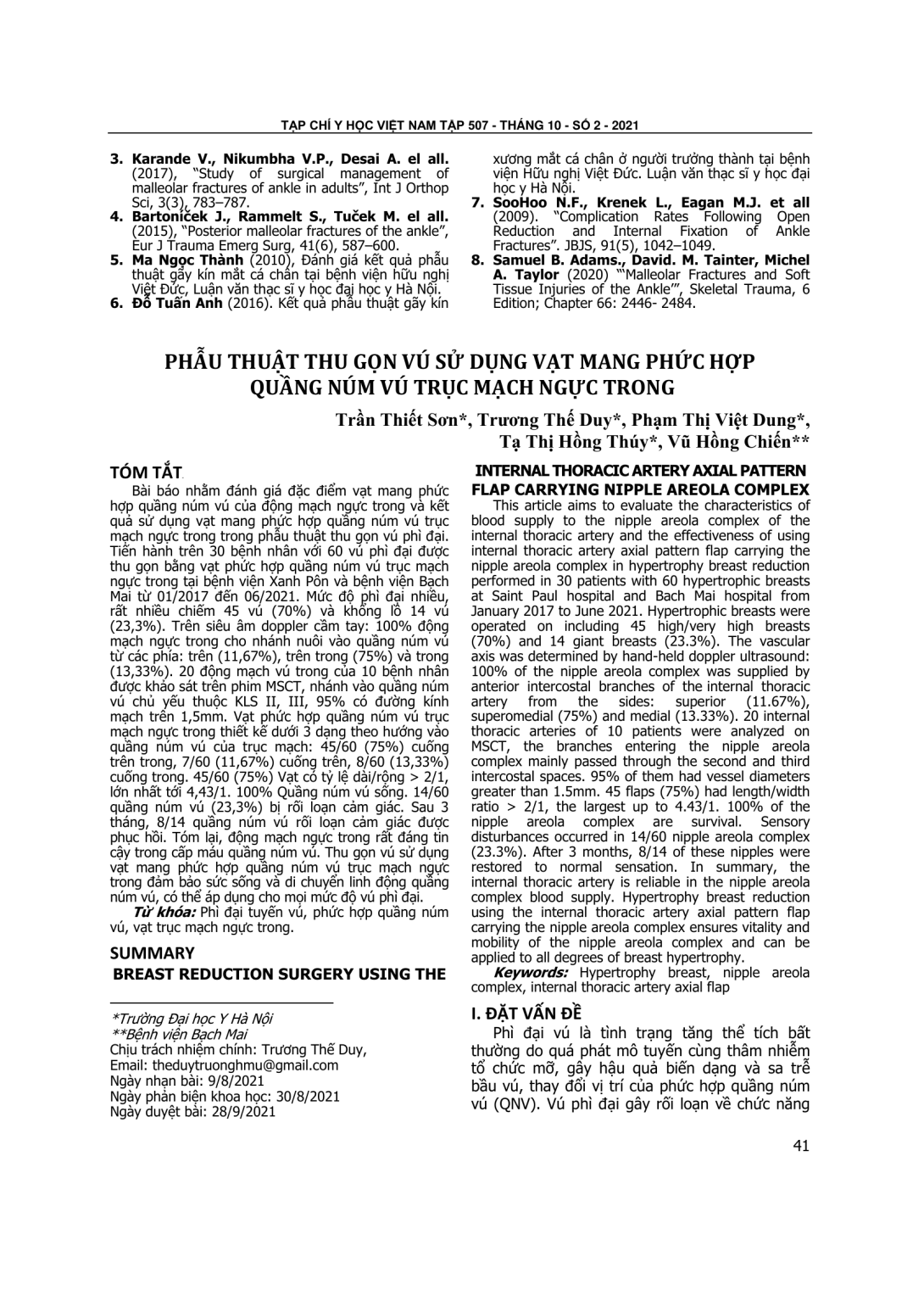
This article aims to evaluate the c-haracteristics of blood supply to the nipple areola complex of the internal thoracic artery and the effectiveness of using internal thoracic artery axial pattern flap carrying the nipple areola complex in hypertrophy breast reduction performed in 30 patients with 60 hypertrophic breasts at Saint Paul hospital and Bach Mai hospital f-rom January 2017 to June 2021. Hypertrophic breasts were operated on including 45 high/very high breasts (70%) and 14 giant breasts (23.3%). The vascular axis was determined by hand-held doppler ultrasound: 100% of the nipple areola complex was supplied by anterior intercostal branches of the internal thoracic artery f-rom the sides: superior (11.67%), superomedial (75%) and medial (13.33%). 20 internal thoracic arteries of 10 patients were analyzed on MSCT, the branches entering the nipple areola complex mainly passed through the second and third intercostal spaces. 95% of them had vessel diameters greater than 1.5mm. 45 flaps (75%) had length/width ratio > 2/1, the largest up to 4.43/1. 100% of the nipple areola complex are survival. Sensory disturbances occurred in 14/60 nipple areola complex (23.3%). After 3 months, 8/14 of these nipples were restored to normal sensation. In summary, the internal thoracic artery is reliable in the nipple areola complex blood supply. Hypertrophy breast reduction using the internal thoracic artery axial pattern flap carrying the nipple areola complex ensures vitality and mobility of the nipple areola complex and can be applied to all degrees of breast hypertrophy.
This article aims to evaluate the c-haracteristics of blood supply to the nipple areola complex of the internal thoracic artery and the effectiveness of using internal thoracic artery axial pattern flap carrying the nipple areola complex in hypertrophy breast reduction performed in 30 patients with 60 hypertrophic breasts at Saint Paul hospital and Bach Mai hospital f-rom January 2017 to June 2021. Hypertrophic breasts were operated on including 45 high/very high breasts (70%) and 14 giant breasts (23.3%). The vascular axis was determined by hand-held doppler ultrasound: 100% of the nipple areola complex was supplied by anterior intercostal branches of the internal thoracic artery f-rom the sides: superior (11.67%), superomedial (75%) and medial (13.33%). 20 internal thoracic arteries of 10 patients were analyzed on MSCT, the branches entering the nipple areola complex mainly passed through the second and third intercostal spaces. 95% of them had vessel diameters greater than 1.5mm. 45 flaps (75%) had length/width ratio > 2/1, the largest up to 4.43/1. 100% of the nipple areola complex are survival. Sensory disturbances occurred in 14/60 nipple areola complex (23.3%). After 3 months, 8/14 of these nipples were restored to normal sensation. In summary, the internal thoracic artery is reliable in the nipple areola complex blood supply. Hypertrophy breast reduction using the internal thoracic artery axial pattern flap carrying the nipple areola complex ensures vitality and mobility of the nipple areola complex and can be applied to all degrees of breast hypertrophy.
- Đăng nhập để gửi ý kiến
